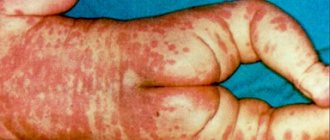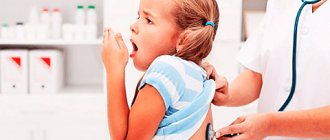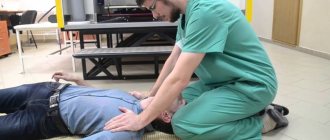What is acetone?
Acetonemic vomiting syndrome (acetone) in children, also known as ketotic hypoglycemia (CH) in childhood, is not a disease, but a metabolic disorder that can begin from 18 months to 5 years, and goes away by itself by 8-9 years of age. It is important to understand that during any illness, stress, or physical activity, the child must be given water, not limit sweets, and be given glucose in solutions and tablets.
With this disorder, the level of ketone bodies (this includes acetone) in the blood, urine and exhaled air increases, and the level of glucose in the blood decreases. The body tries to get rid of excess acetone and removes it through urine and exhaled air. This happens if a child goes hungry for a long time or the body consumes a lot of energy, then blood glucose drops and glycogen reserves are depleted. Since these ketone bodies are an alternative source of energy, when glucose levels are low, they begin to be produced in large quantities, which leads to intoxication of the body, and this, in turn, leads to nausea and vomiting. If normally ketones are detected only in trace amounts, then with this syndrome their amount increases by 50-80 times.
Why do children get acetone?
There is a mechanism for the occurrence of vomiting that is specific to childhood. Let's try to superficially explain its essence. So, the human body receives energy mainly from glucose. Glucose accumulates in the body, primarily in the liver, in the form of a special substance - glycogen. In adults, glycogen reserves are huge, in children they are insignificant. With physical exertion, emotional stress, high body temperature, i.e., with any phenomenon that requires significant energy expenditure from the child’s body, a situation may arise when glycogen reserves run out.
What we have as a result: there is no more glycogen, but energy is still very much needed. As a result, the body begins to receive energy from fat reserves. Intensive breakdown of fat is accompanied by the formation of acetone, which is excreted in the urine (i.e., acetone appears in the urine, which can be determined using special test strips). If there is a deficiency of fluid, acetone accumulates in the blood, irritating the mucous membranes of the gastrointestinal tract and the vomiting center in the brain. Vomiting and abdominal pain occurs. The described situation even received a special name - acetonemic state, and the vomiting that accompanies this condition is called, accordingly, acetonemic vomiting.
Whether a child develops an acetonemic state or not is determined by individual metabolic characteristics: glycogen reserves, the intensity of fat breakdown, and the ability of the kidneys to excrete acetone. Therefore, there are children in whom acetone never accumulates, even at a very high temperature and in a very serious condition, and there are those in whom an acetonemic state occurs in almost any illness - it’s just some kind of punishment.
Diagnosis of the syndrome
To make a correct diagnosis, anamnesis data, patient complaints, clinical manifestations and the results of additional examination are important.
Laboratory tests include a biochemical blood test and a general urine test. Please note that the amount of acetone in children who do not suffer from this disease does not exceed 0.01 grams.
Instrumental diagnostics is echocardioscopy, with which you can see indicators of central hemodynamics. Acetone syndrome is characterized by a decrease in the diastolic volume of the left ventricle and a decrease in venous pressure. Against this background, the cardiac index is increased due to tachycardia.
Recently, you can even test your urine for acetone at home. For this purpose, special indicator test strips are used.
On our website you can familiarize yourself with the qualifications of specialists advising on this issue and learn how to check the level of acetone in children.
Symptoms
How to understand that a child has a tendency to an acetonemic state? After stress, physical and emotional stress, or during illness, the child develops the following signs:
- breath smells like acetone or rotten apples
- suddenly there was a pain in the stomach
- vomit
- weakness or even diarrhea
- the child constantly wants to sleep
This means the body needs glucose. The main thing is to give glucose and water in time, then vomiting can be avoided.
How to reduce acetone in a child at the first signs
Children with neuro-arthritic diathesis are at risk of developing an acetonemic crisis. With such an anomaly of body constitution, the child is nervous, has digestive disorders, and is extremely thin. The first attack usually begins at 2 years of age, repeats until age 7, and resolves by age 12. Parents of children with such special needs need to be especially careful.
The danger is that the crisis occurs suddenly, and at first it is difficult for an inexperienced parent to cope with the task of eliminating the condition and helping the baby. The first sign that you need to start worrying is a change in the child’s behavior and external signs: nervousness, unhealthy complexion, lethargy signal a problem.
Immediately measure the level of acetone in your urine with test strips. If it has increased, the scale will display “++++”, consult a doctor. Up to 3 marks - treat at home. Follow these tips:
- to lower the level of ketones, the main thing is to provide your baby with enough drink (compote, mineral water without alkaline gas);
- Excessive intake of liquid will lead to recurrence of vomiting, be careful;
- if you cannot give water to a child who is vomiting due to frequent attacks, administer the liquid with a pipette;
- Do not allow complete hunger, give a little of the permitted foods.
- If there is persistent deterioration, call an ambulance.
Knowing the algorithm of action during an acetone crisis, you will successfully cope with the problem.
What to do?
Do not panic! Responsibility for the condition of the child lies only with you!
So, the child is nervous, hungry, and has a smell of acetone on his breath - give him a sweet drink, give him some sweets. Coca-Cola is best, because this drink has a lot of sugar and the child will drink it with great pleasure. This category also includes various sweet lemonades and sodas.
Do not put your child on a diet, especially a hungry one, especially one without sweets. This can make the situation worse. Don't limit your child's sweets! It is necessary to ensure that the distance between meals for the child is at least 4 hours.
It is also important to remember that stress in a state of acetonymia is contraindicated, just like a sharp increase in physical activity. You should always carry 40% glucose and candy with you.
If you doubt that your child has acetone, buy special test strips to determine it in urine. These are paper strips with a reagent that changes color depending on the acetone content in the urine.
If the child’s condition is more severe, then it is necessary to start giving him a sweet drink; in this case, saline solutions will only help against dehydration, but will not affect his well-being. But you can give a saline solution in parallel with sweets.
Sometimes it happens that if there is severe vomiting, it is impossible to give the child a sweet drink. In this case, glucose is administered intravenously or an injection of an antiemetic is given, and while it is working, this is about 2-3 hours, you need to let the child drink as much sweet liquid as possible.
If the condition does not improve, vomiting does not stop, and signs of dehydration appear, call an ambulance, as in this case infusion therapy is needed. As soon as the acetone crisis has passed, you just need to forget about it. Do not torment your child with diets, do not look for reasons, but simply live and do not forbid your child sweets, because in 100% of cases children outgrow this condition.
The main thing is to know how to provide first aid and not to scare the child with hospitalization. Of course, there are situations when a hospital cannot be avoided, for example, when intoxication and dehydration of the body are too severe, then the introduction of glucose through a vein is inevitable, but such conditions are very rare and most often we can cope at home ourselves.
It is worth remembering that this condition can develop in an absolutely healthy child, and acetone syndrome without other signs most often does not mean the presence of diabetes. But if acetone appears in a child often for no reason and is accompanied by sudden weight loss, the child often urinates and is constantly thirsty, then it is worth checking for type 1 diabetes.
Preparing a saline solution for dehydration
A treatment method aimed at introducing fluid into the body is called rehydration therapy. Rehydration is, in fact, the replenishment of fluid losses. There are two main methods of rehydration - intravenous, when the necessary solutions are injected into a vein through a dropper, and oral - when a person receives the necessary solutions through the mouth.
What it is? Sometimes it is a ready-made solution, but usually it is a powder, or tablet, or granules, which contain the sodium, potassium, chlorine and other substances necessary for the body in specially selected combinations and concentrations equivalent to pathological losses. Let me explain: sweating is a loss of not only fluid, but also sodium and chlorine (after all, sweat is salty, and everyone probably remembers the school formula NaCl). If you replenish fluid losses, but do not replenish salt losses, this is fraught with serious problems. How much salt do you still need? So smart scientists calculated the optimal amount of salts for a certain volume of water.
The formulas for rehydrating agents are based on these calculations. In addition to salts, the preparations often contain glucose; sometimes extracts of medicinal plants (chamomile extract, for example), and decoctions of cereals (rice, wheat, etc.) are added.
Oral rehydrating agents are an ideal option for quickly and effectively replenishing physiological and pathological fluid losses.
This is why oral rehydration products are over-the-counter medications.
That is why oral rehydration products should be an essential component of a home first aid kit.
Therapeutic measures
At the first signs of the syndrome in question, the child should be reassured and given glucose. The use of a sorbent is also extremely important - it can be enterosgel or even activated carbon. To avoid dehydration, drinking plenty of fluids (mineral water) is recommended. It should be given one tablespoon at a time, but often. The use of antispasmodics is justified.
If vomiting does not stop within an hour, you must call an ambulance, which will provide qualified first aid for acetone in children.
In case of secondary acetone syndrome, treatment of the underlying disease is important.
Prevention
- To prevent CG, high-carbohydrate (bread, cereals, rice, pasta, corn tortillas) and high-protein foods (red meat, chicken and turkey, fish, beans, eggs, nuts) are recommended. Do not allow your child to take long breaks from eating (maximum 6 hours); It is advisable that the child has at least 5 meals a day. A snack before bed is a must (milk, bun, cereal, bananas)!
- In case of an acute infectious disease, fever, nausea, vomiting, or loss of appetite, you should immediately begin giving the child sweet drinks (juices, lemonades, sweet tea, Coca-Cola). It is not necessary and useless to try to feed a child with CG only Borjomi/Narzan/Essentuki/saline solutions: they can prevent dehydration, but without sweet drinks it will not be possible to get the child out of CG, so saline solutions are only an additional measure to sweet drinks.
- If you are constantly vomiting and cannot replace fluid loss at home, you should immediately seek help from a doctor. Only if home drinking does not produce an effect, you should drip solutions intravenously - this method of treatment should not be used as a basic one.
What exactly CG is not:
- CH is not a disease, but only a violation of the tolerance to prolonged fasting
- CG is not a “neuroarthritic diathesis” (there is no such disease). CG is a real problem, “neuro-arthritic diathesis” is a mythical animal, therefore, these two things are not related. What does not exist should not be treated.
- CG does not lead to diabetes and is in no way associated with it.
- CH is not and never has been a “disorder of purine metabolism.” If someone claims the opposite, he does not understand either the metabolism of purines, or the metabolism of carbohydrates, or metabolism in general. CG is not a disorder of uric acid metabolism and is not associated with gout. A restrictive diet is not indicated, it is dangerous and harmful for CG, and people who recommend that children with CG avoid meat and carbohydrates have absolutely no understanding of this condition.
- “Gall bladder bend” is a variant of the normal structure of the gallbladder, and it is very common; this feature is in no way related to CG. By the way, if you have an excess of gallstones, you don’t need a diet either.
- KG is not a kidney disease.
- CG is not a liver disease.
So, the acetonemic state/ketotic hypoglycemia is not a disease, but a metabolic feature that requires the parent not to torment the child with diets and endless searches for the cause, but attention, so as not to miss and prevent the onset of a crisis. Timely drinking and a “sweet diet” will allow the child to safely outgrow this condition.
First aid at home:
- The child's menu requires revision. Exclude: broths from meat, fish and mushrooms, “young” and fatty meat, offal, fermented milk products, legumes, chocolate, citrus fruits, drinks with caffeine or gas
- Frequent fractional drinking in small portions (sweet compote, uzvar, alkaline drink without gas “Borjomi”, “P. Kvasovaya”)
- Sorbents.
- Enema with 2 percent soda solution
- Attempts to feed and water the child provoke increased vomiting, so consultation with a pediatric gastroenterologist is important to determine further tactics for managing the child.
Does your child need help? Consult a medical specialist and receive timely professional help!











